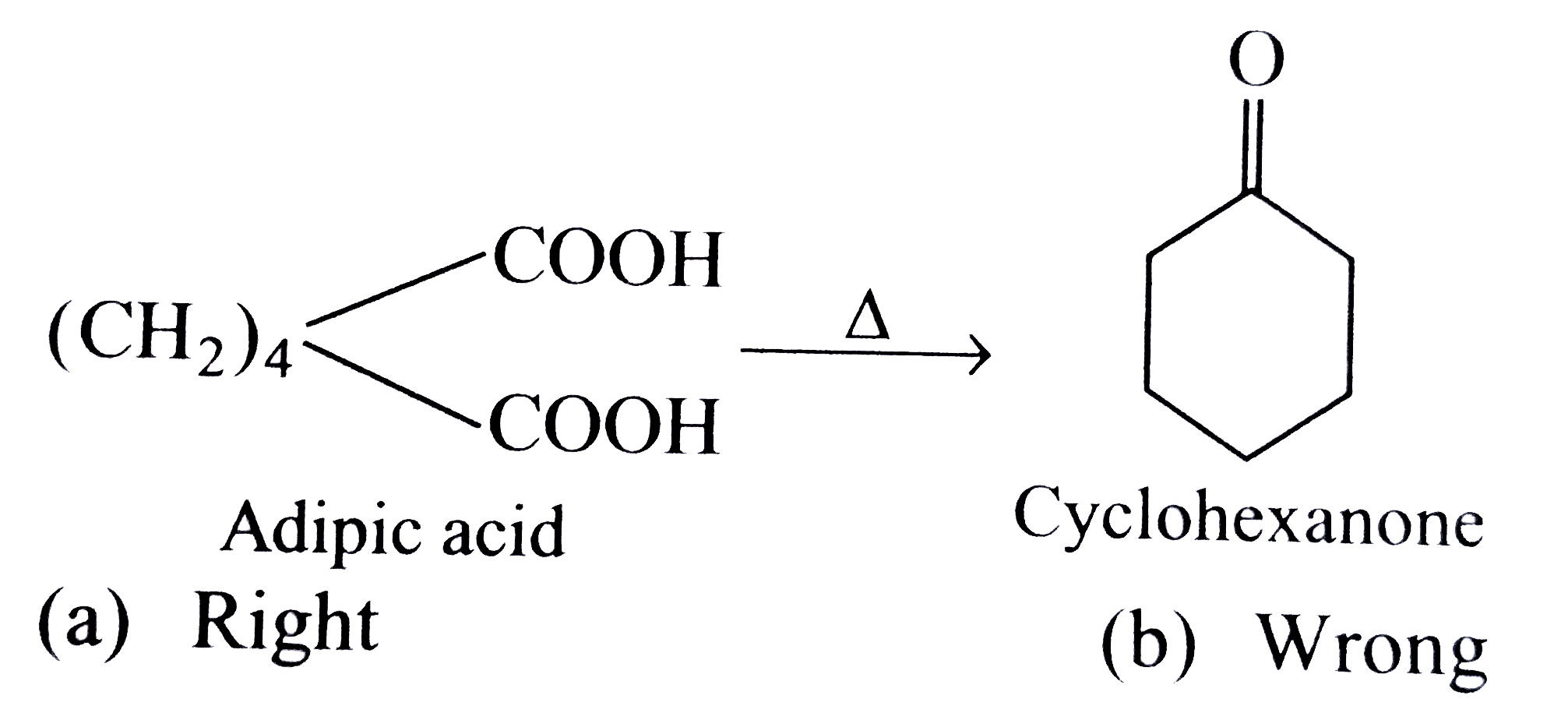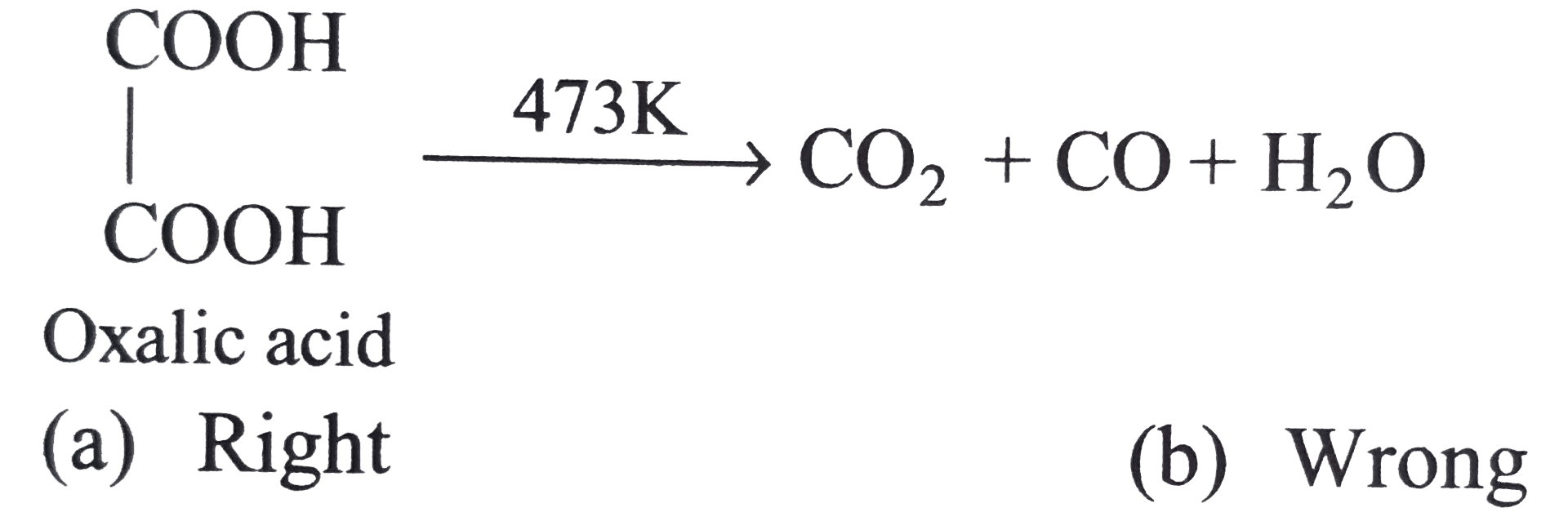Which carboxylic acid (B)(N.E=52gmeq−1) loses CO2 when heated to give an acid (C)N.E=60gmeq−1 ?
If (C) is monocarboxylic acid,
N.E.(Ew)=60
R−COOH=R+45=60
∴R=15=CH3
C=CH3COOH
(B) has one more (−COOH) group which on heating loses (−CO2).
Therefore, it is malonic acid.
⎛⎜
⎜⎝(B)⇒CH2∣COOH−COOH⎞⎟
⎟⎠
N.E(Ew)=MwIonisable H atoms=1042=52gmeq.−1.
Topper's Solved these Questions
- BOOK - CENGAGE CHEMISTRYCHAPTER - CARBOXYLIC ACIDS AND THEIR DERIVATIVESEXERCISE - Exercises (Linked Comprehension)34videos
CARBOXYLIC ACIDS AND THEIR DERIVATIVES
- BOOK - CENGAGE CHEMISTRYCHAPTER - CARBOXYLIC ACIDS AND THEIR DERIVATIVESEXERCISE - Exercises (Multiple Correct)35videos
CARBOXYLIC ACIDS AND THEIR DERIVATIVES
- BOOK - CENGAGE CHEMISTRYCHAPTER - CARBOXYLIC ACIDS AND THEIR DERIVATIVESEXERCISE - Solved Examples17videos
CARBOXYLIC ACIDS AND THEIR DERIVATIVES
- BOOK - CENGAGE CHEMISTRYCHAPTER - BIOMOLECULES, POLYMERS AND CHEMISTRY IN EVERYDAY LIFEEXERCISE - QUESTION BANK8videos
BIOMOLECULES, POLYMERS AND CHEMISTRY IN EVERYDAY LIFE
- BOOK - CENGAGE CHEMISTRYCHAPTER - CHEMICAL KINETICSEXERCISE - Archives Subjective23videos
CHEMICAL KINETICS
Similar Questions
(a) Define the term neutralisation equivalent of an acid.
(b) Find the number of ionisable H atoms for a polycarboxyclic acid (Mw=210gmmol−1) with a neutralisation equivalent if 70gmeq−1. How many equivalents of NaOH would be neutralised by 1mol of this acid ?
( c) Find the neutralisation equivalent of mellitic acid, C6(COOH)6.View SolutionAn organic compound (A) on treatment with ethyl alcohol gives a carboxylic acid (B) and compound (C). The hydrolysis of (C) under acidic conditions gives (B) and (D). Oxidation of (D) with KMnO4 also gives (B). (B) on heating with Ca(OH)2 gives (E) (molecular formula, C3H6O). (E) does not give Tollens test and does not reduce Fehling's solution but forms a 2,4−dinitrophenyl hydrazone. Identify (A),(B),(C),(D), and (E).
View Solution
Knowledge Check
- Question 1 - Select One
Assertion: β-Keto carboxylic acids lose CO2 when heated of about 370K.
Reason : An enol is first formed by loss of CO2, but it readily tautomerises to the more stable ketone.AIf Both assertion and reason are true reason is the correct explation of the assertion.BIf Both assertion and reason are true but reason is not the correct explation of the assertion.CIf assertion is true but reason is false.DIf assertion is false but reason is true. - Question 2 - Select One
A mixture of carboxylic acid (A) and alcohol (B) on heating give and ester (C ) having molecular mass 74. What is (C ) ?
AHCOOC2H5BCH3COOCH3CBoth a and bDNone of these - Question 3 - Select One
Eq. wt of a metal , x g of which reacts with 1 eq. of an acid is
A1Bx/2C2xDx
Variety of products are obtained when dicarboxylic acids are heated. The nature of product depends on the carbon chain length seperating the two carboxylic groups.
(I) 1 ,2 and 1,3-dibasic acids on heating give monocarboxylic acid
(II) 1,4 and 1,5-dibasic acids on heating give cyclic anhydride
(III) 1,6 and 1,7-dibasic acids give cyclic ketones.
Indicate whether the following reactions are right or wrong.
 View Solution
View SolutionVariety of products are obtained when dicarboxylic acids are heated. The nature of product depends on the carbon chain length seperating the two carboxylic groups.
(I) 1 ,2 and 1,3-dibasic acids on heating give monocarboxylic acid
(II) 1,4 and 1,5-dibasic acids on heating give cyclic anhydride
(III) 1,6 and 1,7-dibasic acids give cyclic ketones.
Indicate whether the following reactions are right or wrong.
 View Solution
View SolutionVariety of products are obtained when dicarboxylic acids are heated. The nature of product depends on the carbon chain length seperating the two carboxylic groups.
(I) 1 ,2 and 1,3-dibasic acids on heating give monocarboxylic acid
(II) 1,4 and 1,5-dibasic acids on heating give cyclic anhydride
(III) 1,6 and 1,7-dibasic acids give cyclic ketones.
Indicate whether the following reactions are right or wrong.
 View Solution
View SolutionVariety of products are obtained when dicarboxylic acids are heated. The nature of product depends on the carbon chain length seperating the two carboxylic groups.
(I) 1 ,2 and 1,3-dibasic acids on heating give monocarboxylic acid
(II) 1,4 and 1,5-dibasic acids on heating give cyclic anhydride
(III) 1,6 and 1,7-dibasic acids give cyclic ketones.
Indicate whether the following reactions are right or wrong.
 View Solution
View SolutionVariety of products are obtained when dicarboxylic acids are heated. The nature of product depends on the carbon chain length seperating the two carboxylic groups.
(I) 1 ,2 and 1,3-dibasic acids on heating give monocarboxylic acid
(II) 1,4 and 1,5-dibasic acids on heating give cyclic anhydride
(III) 1,6 and 1,7-dibasic acids give cyclic ketones.
Indicate whether the following reactions are right or wrong.
 View Solution
View Solution

